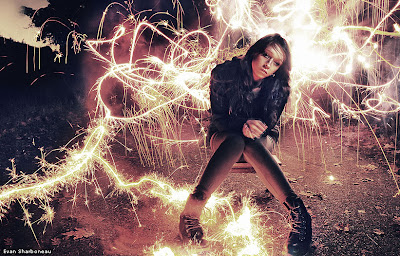 I don't normal do reviews, but I wanted to in this case. "The Trick Photography Book" written by Evan Sharboneau is an in depth and interesting book. In fact I absolutely loved it. It is sure to educate photographers of all stages on the method to get those special effects photographs.
I don't normal do reviews, but I wanted to in this case. "The Trick Photography Book" written by Evan Sharboneau is an in depth and interesting book. In fact I absolutely loved it. It is sure to educate photographers of all stages on the method to get those special effects photographs.
Even for those that may have never picked up a camera in their lives or are using uncomplicated cameras many special effects can still be done. The book even offers to assist photo enthusiasts in a simple and very easy to understand way.
I liked its methods, approaches and was delighted to read the whole book from front to cover. Evan has done himself proud. There is a wealth of information in the book that all photographers, regardless of stage and level, should grab themselves a copy of this book.
Setting the Shutter Speed
Setting the Aperture
Setting the ISO
Setting the White Balance
Long Exposure Effects and Light Painting
Generic Common Settings for Light Paintings
These just a few of the countless things you will come across in the book. There is so much more I can't possible list everything here now.
 Evan is very clever. He talks a lot about lighting and other wonderful photography techniques you can create in the post processing end of your photography. In other words, at the end of your photo creating. I liked the way he went into detail and defined how everything works mutually, from start to finish, to create your final photograph. Lighting is the key to photography and Evan covers this in great detail.
Evan is very clever. He talks a lot about lighting and other wonderful photography techniques you can create in the post processing end of your photography. In other words, at the end of your photo creating. I liked the way he went into detail and defined how everything works mutually, from start to finish, to create your final photograph. Lighting is the key to photography and Evan covers this in great detail.
When you first open the book you are hit with a enormous table of contents. It feels a little much to begin with because the info he provides is so big. He not only goes into all the things you need to know like the best lighting, but talks about cameras, composition, software and other technical details, which he describes very easily and straightforwardly.
High Speed Photography
One of my favourite features to his book was the section High Speed Photography. Want to see what a balloon looks like when it bursts? Its high speed photography but the images look like they have been captured in slow motion. This is the section you won't want to miss. He explains all the equipment you will need (yes you can set this up at home) where to buy the equipment and how to put it all together.
The photos are outstanding. I actually felt myself getting excited by the possibility of shooting my own high speed photographs. I can't wait to try this.
Evan also covers a section on Bubbles and macro photography. The images are stunning and you are truly transported to another world by looking at them. You can generate wonderful effects, abstract photos and extremely exciting photos of close up bubbles. You see the vibrant swirls of the water across the surface of the bubble and the surreal patterns look like something out of a fantasy book.
Photographing smoke is also in the book, fortunately. I am thankful because I get so many photo enthusiasts asking me how to shoot smoke. Now I can refer them to Evans book. I love this part a lot. He talks about the lighting, things to use as backdrops and what you need to precisely capture smoke and produce interesting and amazing patterns. You don't have to use cigarette smoke; you can also use the smoke from an incense stick.
Recommendation- Final Assessment of the ebook
I have been a photographer for a lot of years. I know how hard it can be when you are first starting out to not only take good photos, but particular effects. Evan makes this course of action easy, enjoyable and really enlightening. I highly recommend this book. I am recommending it to all my clients who learn about photography.
It's easy to learn from and fun to create your first special effects photos. I recommend getting yourself a copy of the book. It's worth $97 but I seriously think he should be asking for twice the price. It's worth so much more than it's current outlay. It just shows the generous nature of the author.
Arthur: Amy Renfrey
Do you want to create fantastic and spectacular photos? If yes, I recommend taking a look at Trick Photography and Special Effects by Evan Sharboneau in order to boost and enhance you photos with outstanding special effects!











.jpg)



